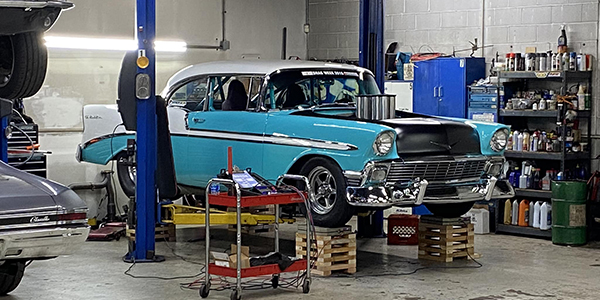For more than 50 years, Babcox Media has covered the rebuilding industry on a monthly basis. At least 633 issues of Automotive Rebuilder and, since 2000, Engine Builder has been dedicated to the business of machining, building, rebuilding and remanufacturing engines.
In our very first issue, we made the promise that we would be devoted “exclusively and 100 percent to your problems, potential and opportunities.” Since October 1964, we have strived to make good on that vow.
And for more than 30 years now, we have reported annually on the “state of the industry.” We have surveyed the machine shop/custom engine rebuilder (CER) population of our readership to get a snapshot of the industry from the soldiers on the front lines.
Some might worry that the “potential” we talked about in Volume 1, Issue 1 might, in fact, be overshadowed by the “problems” this industry has been facing. From a decline in the number of machine shops and engine builders to technical advancements that make engines more durable than ever to consolidation of supplies to changes in what the definition of “professional” is, outsiders might not comprehend why you continue to do what you do.
Remember that third leg of our 1964 mission? Opportunity – by definition, a set of circumstances that makes it possible to do something – still exists in this industry.
The data generated for this year’s Machine Shop Market Profile was collected through survey questionnaires sent to a random sample of active Engine Builder subscribers who are shop owners and managers, many of whom are our fellow members of the Engine Builders Association (AERA). Our questionnaire was developed by Babcox Research to obtain the information contained in our profile. In all, we heard from nearly 240 locations that are performing machine work and building engines in the U.S.
The survey information reflects data for production year 2015. As in years past, we asked multiple questions about readers’ monthly production of engine blocks and cylinder heads, broken out by engine size as well as by gas and diesel configurations, crankshafts, core sourcing, shop equipment ownership and purchasing, and total production time spent in specific engine building areas.
A complete copy of the charts used to generate this article is available on EngineBuilderMag.com or by contacting Babcox Market Research at 330-670-1234.
Nationally, the numbers look like this: the average machine shop produced slightly more than 25 gas and diesel engines monthly last year, up from 24.4 in 2014. This positive trend has reached its highest point in the past eight years and the increases have been primarily on the gas side. A slight decline was seen in four-cylinder gasoline engines (down slightly less than an engine per month from 2014), six-cylinder gas engine production increased 1.2 engines per month (up to 3.6 per month from 2.8 per month in last year’s report). Add to that increases in the number of eight-cylinder (10.2 per month, up from 9.4) and “other” engines (up to 1.5 per month), and you see that gas engine production is higher than at any time since at least 2008.
Diesel has actually slipped slightly. An average of one four-cylinder, one six-cylinder and one eight-cylinder engine was built per shop per month in 2015. Although this number is down a third-of-an-engine per month, we know from anecdotal information from readers that industrial, commercial and agricultural engines continue to offer opportunities to rebuilders. Overall, the number of diesel engines was three engines per month.
This average national monthly gas and diesel engine production of 25.1 units translates to 301 engines produced annually. This is up from the 292 reported last year. Projected onto a universe of 3,000 to 5,000 full-service machine shops, it’s estimated that CERs accounted for between 902,000 to 1.505 million gas and diesel engines built during production year 2015. Last year, the market range for the same size universe was 879,000 to 1.46 million units.
If you add in an estimated 450,000 engines remanufactured annually by approximately 30 North American production engine remanufacturers (PERs), the combined total number of engines rebuilt in 2015 by CERs and PERs would be approximately 1.352 million to 1.955 million units. This compares to an upper range of approximately 1.91 million engines produced by PERs and CERs during production year 2013.
At an average retail cost of approximately $2,600 per engine, we calculate that the total rebuilt/remanufactured engine market generated between $3.52 billion and $5.08 billion in rebuilt engine sales in 2015.
It’s hard to be all things for all people, but in the CER business diversity is the name of the game. Our 2015 numbers show that more than 85 percent of our respondents build standard passenger car and light truck gasoline engines, a number that has, not surprisingly, been in decline. The remaining categories from there are: performance gas – 82.8 percent; automotive diesel – 35.6 percent; marine engines – 60.6 percent; industrial engines – 37.8 percent; medium-duty diesel – 21.8 percent; heavy-duty diesel – 41.8 percent; performance diesel – 15.1 percent; motorcycle/mower/other small engines – 32.4 percent; and “other types” – 11.3 percent.
We asked survey respondents, “What percentage of your shop’s engine rebuilding activity falls into each of the following categories?” Answers had to total 100 percent, and the results were as follows: automotive gas – 37.3 percent; performance – 31.7 percent; industrial – 7.7 percent; medium-duty diesel – 1.9 percent; automotive diesel – 3.6 percent; performance diesel – 1.2 percent; marine engines – 2.8 percent; heavy-duty diesel – 4.8 percent; motorcycle/mower/other small – 3.9 percent; and other types – 5.0 percent.
When it made its debut as the L-48 option in the 1967 Camaro, the small block Chevy 350 made waves – but few would have guessed then that the engine would continue to be so popular in the industry. As has come to be expected, the 350 continues its position at the top of the chart – though other engines in the GM family (without question the LS platform) are gaining traction. The 350 is ranked as the number one engine built by 45.3 percent of our respondents, slightly up from last year. However, a GM engine of some kind is listed number one by almost 71 percent of our respondents. Fords account for 11.2 percent; Heavy-Duty and Commercial engines account for almost 16 percent (up from the previous two years); and “other engines” saw a big drop to 1.4 percent from the previous 2.3 percent. Imports were listed number one by 1.1 percent of respondents.
Survey respondents provide information about their engine building business by breaking down their operation into five specific machining processes – production of short blocks, long blocks, complete engines, cylinder heads (not used on long blocks or complete engines) and crankshafts (also not used in long blocks or complete engines).
A slight decrease in the number of 4 and 6 cylinder gas heads rebuilt each month resulted in a dip of almost one head per month, from 2014’s 40 to last year’s 39.2. Diesel stayed steady – 11 diesel heads were rebuilt per month, equal to 2014.
Gas cylinder heads accounted for about 42.2 percent of the typical shop’s production in 2015, down from 46 percent. In 2014, shops produced an average total of 51.7 gas and diesel heads per month, but in 2015 that number was 50.2 heads produced monthly.
Gas cylinder head work remains the single highest number produced monthly, but complete engines have had a refreshing resurgence, accounting for the highest percentage in the past three years. Complete engines account for 34.4 percent of the total rebuilder’s business.
For diesel engine builders, an increase was seen in crank production in 2015, while short blocks, long blocks and cylinder head production numbers saw a drop from 2014. As with the gasoline segment, complete engines were a bright spot – on average, complete engines accounted for 14.4 percent of a shop’s diesel business in 2015, up from 13 percent the previous year.
The national average number of gas and diesel crankshafts reground monthly by the typical CER climbed from 26.7 units in 2014 to 29 units in 2015. Diesel crank production increased in 2015 relative to 2014 as well, jumping from 6.5 to 8 total units per month. Gasoline crankshaft regrinding also climbed, from 20 total units produced monthly during 2014 to 21 total units produced in 2015.
As mentioned, diesel heads rebuilt monthly remained about steady from last year’s survey. Total diesel cylinder head production decreased from 11.2 units rebuilt monthly in 2014 to 11 units in 2015. Six-cylinder diesel head production actually increased from 3.8 to 5 per month and “others” stayed even at 1, but four- and eight-cylinder head production saw slight declines.
The percentage of cylinder head rebuilding that is aluminum continued to climb in 2015, from the previous year’s 56 percent, to a dramatic 65.6 percent. The percentage of cylinder head rebuilding that is diesel fell about two percent from 2014.
The percentage of cylinder head production that is import related is 34 percent, up from 27 percent in 2014.
As we’ve discussed in the pages of Engine Builder for many years, the requirements of today’s modern engine building operations include unprecedented cleaning standards, extremely tight tolerances and precise surface finishes. The engine builder/machine shop performs a wide variety of jobs in its daily operation – the “big five” operations have all seen increases with this survey. Shops are spending a greater percentage of their time on disassembly/cleaning, valve guide and seat work, cylinder head resurfacing, cylinder boring and valve reconditioning. Flywheel grinding is also seeing increased importance in the shop’s daily operations.
After years of being tight with budget, shops have continued to spend in order to buy equipment needed for these operations. In 2015, the average shop spent $30,343 on equipment, a strong increase from the $24,585 that was spent in 2014. Average value of the typical machine shop’s equipment is $227,643.
Like Benjamin Button, the typical shop continues to get younger – the national average for the number of years a shop has been in business is 24 years, an age that has continued to fall. Last year’s survey average was 26.6 years; two years ago, we reported an average of 30.2 years.
Of course, continued growth in the number of shops that have been in business less than 10 years will do that. Nearly a quarter of our respondents say they have been in business less than 10 years and almost half haven’t yet seen their 20th anniversary.
For the first time in the past several years, we had no businesses report being in business over 60 years, although we know you’re still out there. The concern about veterans taking the engine building knowledge with them remains, and we know that our allies in the educational facilities are doing their best to teach the up-and-comers how to do the work properly, we encourage our most seasoned readers to support their Chambers of Commerce and other local organizations to get the word out about the opportunities that continue to exist. Our sister publication, Tomorrow’s Tech (tomorrowstechnician.com) supports technical education at more than 1,600 technical and vocational schools nationwide.
The average number of total company employees is 6.4 and the average number of machine shop employees is 2.6 per shop. This number has actually remained fairly consistent for the past several years. The average tenure of employees is 17 years.
For an expanded version of this report, visit www.EngineBuilderMag.com.



